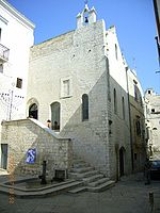
Synagogue architecture
Encyclopedia
Synagogue architecture often follows styles in vogue at the place and time of construction. There is no set blueprint for synagogues and the architectural shapes and interior designs of synagogues vary greatly. According to tradition, the Divine Presence (Shekhinah
) can be found wherever there is a minyan
, a quorum, of ten. A synagogue always contains an ark, called aron ha-kodesh by Ashkenazim and hekhal
by Sephardim, where the Torah
scrolls are kept.
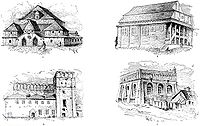 The ark may be more or less elaborate, even a cabinet not structurally integral to the building or a portable arrangement whereby a Torah is brought into a space temporarily used for worship. There must also be a table from which the Torah is read. The table, called bimah
The ark may be more or less elaborate, even a cabinet not structurally integral to the building or a portable arrangement whereby a Torah is brought into a space temporarily used for worship. There must also be a table from which the Torah is read. The table, called bimah
by eastern Ashkenazim, almemmar (or balemmer) by Central and Western Ashkenazim and tebah by Sephardim, where the Torah is read (and from where the services are conducted in Sephardi synagogues) can range from an elaborate platform integral to the building (many early modern synagogues of central Europe featured bimahs with pillars that rose to support the ceiling), to elaborate free-standing raised platforms, to simple tables. A ner tamid, a constantly lit light as a reminder of the constantly lit menorah of the Temple in Jerusalem
. Many synagogues, mainly in Ashkenazi communities, feature a pulpit facing the congregation from which to address the assembled. All synagogues require an amud (Hebrew
for "post" or "column"), a desk facing the Ark from which the Hazzan
(reader, or prayer leader) leads the prayers.
A synagogue may or may not have artwork, synagogues range form simple, unadorned prayer rooms to elaborately decorated buildings in every architectural style.
The synagogue, or if it is a multi-purpose building, prayer sanctuaries within the synagogue, should face towards Jerusalem. Thus sanctuaries in the Western world generally face east, while those east of Israel face west. Sanctuaries in Israel face towards Jerusalem. But this orientation need not be exact, and occasionally synagogues face other directions for structural reasons, in which case the community may face Jerusalem when standing for prayers.
 There are only a few Talmud
There are only a few Talmud
ic instructions on how synagogues could be built, namely that they had to have windows and that they had to be taller than other buildings in town, synagogue plans were generally unrestricted, and even these few rules were often disregarded (especially as Jews were often not allowed to build tall buildings). There is no set blueprint
for synagogues and the architectural shapes as well as interior designs of synagogues vary greatly.
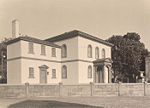
 Historically, synagogues were built in the prevailing architectural style of their time and place. Thus, the synagogue in Kaifeng, China
Historically, synagogues were built in the prevailing architectural style of their time and place. Thus, the synagogue in Kaifeng, China
looked very like Chinese temples of that region and era, with its outer wall and open garden in which several buildings were arranged.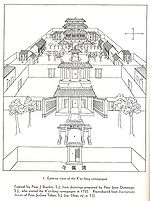 The styles of the earliest synagogues resembled the temples of other sects of the eastern Roman Empire. The synagogues of Morocco are embellished with the colored tilework characteristic of Moroccan architecture. The surviving medieval synagogues in Budapest
The styles of the earliest synagogues resembled the temples of other sects of the eastern Roman Empire. The synagogues of Morocco are embellished with the colored tilework characteristic of Moroccan architecture. The surviving medieval synagogues in Budapest
, Prague
and the German lands are typical Gothic
structures.
For much of history, the constraints of anti-semitism
and the laws of host countries restricting the building of synagogues visible from the street, or forbidding their construction altogether, meant that synagogues were often built within existing buildings, or opening form interior courtyards. In both Europe and in the Muslim world, old synagogues with elaborate interior architecture can be found hidden within nondescript buildings.
Where the building of synagogues was permitted, they were built in the prevailing architectural style of the time and place. Many European cities had elaborate Renaissance synagogues, of which a few survive. In Italy there were many synagogues in the style of the Italian Renaissance (see Leghorn; Padua; and Venice). Those in Padua and Venice possess interiors of great beauty, and are excellent examples of Renaissance work. With the coming of the Baroque era, Baroque synagogues appeared across Europe.
The emancipation of Jews in Europe
an countries and of Jews in Muslim countries colonized by European countries gave Jews the right to build large, elaborate synagogues visible from the public street. Synagogue architecture blossomed. Large Jewish communities wished to show not only their wealth but also their newly acquired status as citizens by constructing magnificent synagogues. Handsome nineteenth synagogues form the period of Jewish imagination stand in virtually every country where there were Jewish communities. Most were built in revival styles then in fashion. Thus there were Neoclassical
, Neo-Byzantine, Romanesque Revival Moorish Revival
, Gothic Revival, and Greek Revival. There are Egyptian Revival synagogues and even one Mayan Revival
synagogue. In the nineteenth and early twentieth century heyday of historicist architecture, however, most historicist synagogues, even the most magnificent ones, did not attempt a pure style, or even any particular style, and are best described as eclectic.
In the post-war era, synagogue architecture abandoned historicist styles for modernism.
Chabad Lubavitch has made a practice of designing some of its Chabad House
s and centers as replicas of or homages to the architecture of 770 Eastern Parkway
http://www.shmais.com/pages.cfm?page=photo_gallery&ID=191.
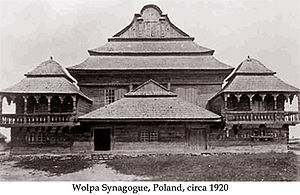 The great exceptions to the rule that synagogues are built in the prevailing style of their time and place are the Wooden synagogues of Eastern Europe
The great exceptions to the rule that synagogues are built in the prevailing style of their time and place are the Wooden synagogues of Eastern Europe
. They were a unique Jewish artistic and architectural form Characteristic features include the independence of the pitched roof from the design of the interior domed ceiling. Elaborately carved, painted, domed, balconied and vaulted interiors. The architectural interest of the exterior lay in the large scale of the buildings, the multiple, horizontal lines of the tiered roofs, and the carved corbel
s that supported them. Wooden synagogues featured a single, large hall. In contrast to contemporary churches, there was no apse
. Moreover, while contemporary churches featured imposing vestibules, the entry porches of the wooden synagogues was a low annex, usually with a simple lean-to roof. In these synagogues, the emphasis was on constructing a single, large, high-domed worship space.
According to art historian Stephen S. Kayser, the wooden synagogues of Poland with their painted and carved interiors were “a truly original and organic manifestation of artistic expression—the only real Jewish folk art in history.”
According to Louis Lozowick
, writing in 1947, the wooden synagogues were unique because, unlike all previous synagogues, they were not built in the architectural style of their region and era, but in a newly evolved and uniquely Jewish style, making them "a truly original folk expression," whose "originality does not lie alone in the exterior architecture, it lies equally in the beautiful and intricate wood carving of the interior."
Moreover, while in many parts of the world Jews were proscribed from entering the building trades and even from practicing the decorative arts of painting and woodcarving, the wooden synagogues were actually built by Jewish craftsmen.
Art historian Ori Z. Soltes points out that the wooden synagogues, unusual for that period in being large, identifiably Jewish buildings not hidden in courtyards or behind walls, were built not only during a Jewish "intellectual golden age" but in a time and place where "the local Jewish population was equal to or even greater than the Christian population.
 In medieval Spain
In medieval Spain
(both Al-Andalus
and the Christian kingdoms), a host of synagogues were built, and it was usual to commission them from Moorish architects. This constructions, built with Moorish techniques and style are framed in the Mudéjar
architecture. Very few of these medieval synagogues are conserved: The two best known Spanish synagogues are in Toledo
, one known as El Tránsito, the other as Santa María la Blanca
, and both, undoubtedly very beautiful, are now preserved as national monuments. The former is a small building containing very rich decorations; the latter is especially noteworthy. It is based upon Almohad style and contains long rows of octagonal columns with curiously carved capitals, from which spring Moorish arches supporting the roof.
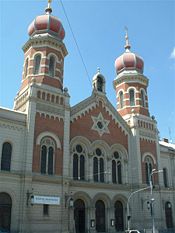 Another significative Mudéjar synagogue is the one at Córdoba
Another significative Mudéjar synagogue is the one at Córdoba
built in 1315. As in El Tránsito, the vegetal and geometrical stucco decorations are purely Moorish, but unlike the former, the epigraphic texts are in Hebrew. After the expulsion from Spain there was a general feeling among wealthy Sephardim that Moorish architecture was appropriate in synagogues, and many of the most famous ones in the world have been constructed in this style, although Moorish architecture is by no means Jewish, either in fact or in feeling. The Alhambra
has furnished inspiration for innumerable synagogues, but seldom have its graceful proportions or its delicate modeling and elaborate ornamentation been successfully copied.
, Art Deco
, International style, and all contemporary styles. In the post-World War II period "a period of post-war modernism," came to the fore, "characterized by assertive architectural gestures that had the strength and integrity to stand alone, without applied artwork or Jewish iconography."
at the eastern end opposite the entrance, and with an almemar or pulpit. In older or Orthodox synagogues with separate seating, there may be benches for the men on either side, and a women's gallery reached by staircases from the outer vestibule. Variations of this simple plan abound: the vestibule became larger, and the stair-cases to the women's gallery were separated from the vestibule and given more importance. As the buildings became larger, rows of columns were required to support the roof, but in every case the basilican form was retained. The Ark, formerly allowed a mere niche in the wall, was developed into the main architectural feature of the interior, and was flanked with columns, covered with a canopy and richly decorated. The almemar in many cases was joined to the platform in front of the Ark, and elaborate arrangements of steps were provided.
. The position of the pulpit varies; it may be placed on either side of the Ark, and is occasionally found in the center of the steps.
For the thirty-three synagogues of India
, American architect and professor of architecture Jay A. Waronker has learned that these buildings tend to follow the Sephardic traditions of the tevah (or bimah, the raised platform where the service is led and Torah read) being freestanding and roughly in the middle of the sanctuary and the ark (called the hekhal by Sephardim and the aron ha-kodesh by Ashkenazim) engaged along the wall that is closest to Jerusalem. The hekhals are esstentially cabinets or armoires storing the sefer Torahs. Seating, in the form of long wooden benches, is grouped around and facing the tevah. Men sit together on the main level of the sanctuary while women sit in a dedicated zone on the same level in the smaller synagogues or upstairs in a women's gallery.
Interesting architectural and planning exceptions to this common Sephardic formula are the Cochin synagogues in Kerala of far southwestern India. Here, on the gallery level and adjacent to the space provided for women and overlooking the sanctuary below, is a second tevah. This tevah was used for holidays and unique occasions. It is therefore interesting, on more special events, the woman are closest to the point where the religious service is being led.
In Baghdadi synagogues of India, the hekhals appear to be standard-sized cabinets from the outside (the side facing the sanctuary), but when opened a very large space is revealed. They are essentially walk-in rooms with a perimeter shelf holding up to one hundred sefer Torahs.
synagogues. The perpetual lamp hangs in front of the Ark; the tables of the Law surmount it. The seven-branched candlestick, or menorah, may be placed at the sides. Occasionally the shofar
, and even the lulav
, may be utilized in the design. Hebrew inscriptions are sparingly or seldom used; stained-glass windows, at one time considered the special property of the Church, are now employed, but figured subjects are not used.
Shekhinah
Shekinah is the English spelling of a grammatically feminine Hebrew word that means the dwelling or settling, and is used to denote the dwelling or settling divine presence of God, especially in the Temple in Jerusalem.-Etymology:Shekinah is derived...
) can be found wherever there is a minyan
Minyan
A minyan in Judaism refers to the quorum of ten Jewish adults required for certain religious obligations. According to many non-Orthodox streams of Judaism adult females count in the minyan....
, a quorum, of ten. A synagogue always contains an ark, called aron ha-kodesh by Ashkenazim and hekhal
Hekhal
The Hebrew noun hekhal in Classical Hebrew means a large building. This can be either the main building of the Temple in Jerusalem, that is the nave or sanctuary of the Temple, or a palace, such as the "palace" of Ahab king of Samaria, or the "palace" of the King of Babylon.-Usage:It is used 80...
by Sephardim, where the Torah
Torah
Torah- A scroll containing the first five books of the BibleThe Torah , is name given by Jews to the first five books of the bible—Genesis , Exodus , Leviticus , Numbers and Deuteronomy Torah- A scroll containing the first five books of the BibleThe Torah , is name given by Jews to the first five...
scrolls are kept.
Blueprint for synagogues

Bimah
A bimah A bimah A bimah (among Ashkenazim, derived from Hebrew בּמה , almemar (from Arabic al-minbar) or tebah (among Sephardim) is the elevated area or platform in a Jewish synagogue which is intended to serve the place where the person reading aloud from the Torah stands during the Torah reading...
by eastern Ashkenazim, almemmar (or balemmer) by Central and Western Ashkenazim and tebah by Sephardim, where the Torah is read (and from where the services are conducted in Sephardi synagogues) can range from an elaborate platform integral to the building (many early modern synagogues of central Europe featured bimahs with pillars that rose to support the ceiling), to elaborate free-standing raised platforms, to simple tables. A ner tamid, a constantly lit light as a reminder of the constantly lit menorah of the Temple in Jerusalem
Temple in Jerusalem
The Temple in Jerusalem or Holy Temple , refers to one of a series of structures which were historically located on the Temple Mount in the Old City of Jerusalem, the current site of the Dome of the Rock. Historically, these successive temples stood at this location and functioned as the centre of...
. Many synagogues, mainly in Ashkenazi communities, feature a pulpit facing the congregation from which to address the assembled. All synagogues require an amud (Hebrew
Hebrew language
Hebrew is a Semitic language of the Afroasiatic language family. Culturally, is it considered by Jews and other religious groups as the language of the Jewish people, though other Jewish languages had originated among diaspora Jews, and the Hebrew language is also used by non-Jewish groups, such...
for "post" or "column"), a desk facing the Ark from which the Hazzan
Hazzan
A hazzan or chazzan is a Jewish cantor, a musician trained in the vocal arts who helps lead the congregation in songful prayer.There are many rules relating to how a cantor should lead services, but the idea of a cantor as a paid professional does not exist in classical rabbinic sources...
(reader, or prayer leader) leads the prayers.
A synagogue may or may not have artwork, synagogues range form simple, unadorned prayer rooms to elaborately decorated buildings in every architectural style.
The synagogue, or if it is a multi-purpose building, prayer sanctuaries within the synagogue, should face towards Jerusalem. Thus sanctuaries in the Western world generally face east, while those east of Israel face west. Sanctuaries in Israel face towards Jerusalem. But this orientation need not be exact, and occasionally synagogues face other directions for structural reasons, in which case the community may face Jerusalem when standing for prayers.
Style

Talmud
The Talmud is a central text of mainstream Judaism. It takes the form of a record of rabbinic discussions pertaining to Jewish law, ethics, philosophy, customs and history....
ic instructions on how synagogues could be built, namely that they had to have windows and that they had to be taller than other buildings in town, synagogue plans were generally unrestricted, and even these few rules were often disregarded (especially as Jews were often not allowed to build tall buildings). There is no set blueprint
Blueprint
A blueprint is a type of paper-based reproduction usually of a technical drawing, documenting an architecture or an engineering design. More generally, the term "blueprint" has come to be used to refer to any detailed plan....
for synagogues and the architectural shapes as well as interior designs of synagogues vary greatly.


Kaifeng
Kaifeng , known previously by several names , is a prefecture-level city in east-central Henan province, Central China. Nearly 5 million people live in the metropolitan area...
looked very like Chinese temples of that region and era, with its outer wall and open garden in which several buildings were arranged.

Budapest
Budapest is the capital of Hungary. As the largest city of Hungary, it is the country's principal political, cultural, commercial, industrial, and transportation centre. In 2011, Budapest had 1,733,685 inhabitants, down from its 1989 peak of 2,113,645 due to suburbanization. The Budapest Commuter...
, Prague
Prague
Prague is the capital and largest city of the Czech Republic. Situated in the north-west of the country on the Vltava river, the city is home to about 1.3 million people, while its metropolitan area is estimated to have a population of over 2.3 million...
and the German lands are typical Gothic
Gothic architecture
Gothic architecture is a style of architecture that flourished during the high and late medieval period. It evolved from Romanesque architecture and was succeeded by Renaissance architecture....
structures.
For much of history, the constraints of anti-semitism
Anti-Semitism
Antisemitism is suspicion of, hatred toward, or discrimination against Jews for reasons connected to their Jewish heritage. According to a 2005 U.S...
and the laws of host countries restricting the building of synagogues visible from the street, or forbidding their construction altogether, meant that synagogues were often built within existing buildings, or opening form interior courtyards. In both Europe and in the Muslim world, old synagogues with elaborate interior architecture can be found hidden within nondescript buildings.
Where the building of synagogues was permitted, they were built in the prevailing architectural style of the time and place. Many European cities had elaborate Renaissance synagogues, of which a few survive. In Italy there were many synagogues in the style of the Italian Renaissance (see Leghorn; Padua; and Venice). Those in Padua and Venice possess interiors of great beauty, and are excellent examples of Renaissance work. With the coming of the Baroque era, Baroque synagogues appeared across Europe.
The emancipation of Jews in Europe
Europe
Europe is, by convention, one of the world's seven continents. Comprising the westernmost peninsula of Eurasia, Europe is generally 'divided' from Asia to its east by the watershed divides of the Ural and Caucasus Mountains, the Ural River, the Caspian and Black Seas, and the waterways connecting...
an countries and of Jews in Muslim countries colonized by European countries gave Jews the right to build large, elaborate synagogues visible from the public street. Synagogue architecture blossomed. Large Jewish communities wished to show not only their wealth but also their newly acquired status as citizens by constructing magnificent synagogues. Handsome nineteenth synagogues form the period of Jewish imagination stand in virtually every country where there were Jewish communities. Most were built in revival styles then in fashion. Thus there were Neoclassical
Neoclassical architecture
Neoclassical architecture was an architectural style produced by the neoclassical movement that began in the mid-18th century, manifested both in its details as a reaction against the Rococo style of naturalistic ornament, and in its architectural formulas as an outgrowth of some classicizing...
, Neo-Byzantine, Romanesque Revival Moorish Revival
Moorish Revival
Moorish Revival or Neo-Moorish is one of the exotic revival architectural styles that were adopted by architects of Europe and the Americas in the wake of the Romanticist fascination with all things oriental...
, Gothic Revival, and Greek Revival. There are Egyptian Revival synagogues and even one Mayan Revival
Mayan Revival
The Mayan Revival is a modern architectural movement, primarily of the 1920s and 30s, that drew inspiration from the architecture and iconography of pre-Columbian Mesoamerican cultures.- Origins :...
synagogue. In the nineteenth and early twentieth century heyday of historicist architecture, however, most historicist synagogues, even the most magnificent ones, did not attempt a pure style, or even any particular style, and are best described as eclectic.
In the post-war era, synagogue architecture abandoned historicist styles for modernism.
Chabad Lubavitch has made a practice of designing some of its Chabad House
Chabad house
A Chabad house is a centre for disseminating Orthodox Judaism by the Chabad movement. Chabad Houses are run by the local Shaliach , who was sent to that place by the Lubavitcher Rebbe, Rabbi Menachem Mendel Schneerson, who founded all Chabad Houses...
s and centers as replicas of or homages to the architecture of 770 Eastern Parkway
770 Eastern Parkway
770 Eastern Parkway is the street address of the central headquarters of the Chabad-Lubavitch Hasidic movement, located on Eastern Parkway in the Crown Heights section of Brooklyn, New York, in the United States of America...
http://www.shmais.com/pages.cfm?page=photo_gallery&ID=191.
Eastern European Wooden Synagogues

Wooden synagogues of Eastern Europe
Wooden synagogues are an original style of Synagogue architecture that developed in the Polish-Lithuanian commonwealth.- Uniqueness as an artistic and architectural form :...
. They were a unique Jewish artistic and architectural form Characteristic features include the independence of the pitched roof from the design of the interior domed ceiling. Elaborately carved, painted, domed, balconied and vaulted interiors. The architectural interest of the exterior lay in the large scale of the buildings, the multiple, horizontal lines of the tiered roofs, and the carved corbel
Corbel
In architecture a corbel is a piece of stone jutting out of a wall to carry any superincumbent weight. A piece of timber projecting in the same way was called a "tassel" or a "bragger". The technique of corbelling, where rows of corbels deeply keyed inside a wall support a projecting wall or...
s that supported them. Wooden synagogues featured a single, large hall. In contrast to contemporary churches, there was no apse
Apse
In architecture, the apse is a semicircular recess covered with a hemispherical vault or semi-dome...
. Moreover, while contemporary churches featured imposing vestibules, the entry porches of the wooden synagogues was a low annex, usually with a simple lean-to roof. In these synagogues, the emphasis was on constructing a single, large, high-domed worship space.
According to art historian Stephen S. Kayser, the wooden synagogues of Poland with their painted and carved interiors were “a truly original and organic manifestation of artistic expression—the only real Jewish folk art in history.”
According to Louis Lozowick
Louis Lozowick
Louis Lozowick was an American painter and a printmaker. He was born in Russian Empire , came to United States in 1906, and died in New Jersey in 1973...
, writing in 1947, the wooden synagogues were unique because, unlike all previous synagogues, they were not built in the architectural style of their region and era, but in a newly evolved and uniquely Jewish style, making them "a truly original folk expression," whose "originality does not lie alone in the exterior architecture, it lies equally in the beautiful and intricate wood carving of the interior."
Moreover, while in many parts of the world Jews were proscribed from entering the building trades and even from practicing the decorative arts of painting and woodcarving, the wooden synagogues were actually built by Jewish craftsmen.
Art historian Ori Z. Soltes points out that the wooden synagogues, unusual for that period in being large, identifiably Jewish buildings not hidden in courtyards or behind walls, were built not only during a Jewish "intellectual golden age" but in a time and place where "the local Jewish population was equal to or even greater than the Christian population.
Moorish influence

Spain
Spain , officially the Kingdom of Spain languages]] under the European Charter for Regional or Minority Languages. In each of these, Spain's official name is as follows:;;;;;;), is a country and member state of the European Union located in southwestern Europe on the Iberian Peninsula...
(both Al-Andalus
Al-Andalus
Al-Andalus was the Arabic name given to a nation and territorial region also commonly referred to as Moorish Iberia. The name describes parts of the Iberian Peninsula and Septimania governed by Muslims , at various times in the period between 711 and 1492, although the territorial boundaries...
and the Christian kingdoms), a host of synagogues were built, and it was usual to commission them from Moorish architects. This constructions, built with Moorish techniques and style are framed in the Mudéjar
Mudéjar
Mudéjar is the name given to individual Moors or Muslims of Al-Andalus who remained in Iberia after the Christian Reconquista but were not converted to Christianity...
architecture. Very few of these medieval synagogues are conserved: The two best known Spanish synagogues are in Toledo
Toledo, Spain
Toledo's Alcázar became renowned in the 19th and 20th centuries as a military academy. At the outbreak of the Spanish Civil War in 1936 its garrison was famously besieged by Republican forces.-Economy:...
, one known as El Tránsito, the other as Santa María la Blanca
Santa María la Blanca
300px|thumb|Interior of Santa María la Blanca.Santa María la Blanca is a museum and former synagogue in Toledo, Spain. Erected in 1180, it is disputably considered the oldest synagogue building in Europe still standing...
, and both, undoubtedly very beautiful, are now preserved as national monuments. The former is a small building containing very rich decorations; the latter is especially noteworthy. It is based upon Almohad style and contains long rows of octagonal columns with curiously carved capitals, from which spring Moorish arches supporting the roof.

Córdoba, Spain
-History:The first trace of human presence in the area are remains of a Neanderthal Man, dating to c. 32,000 BC. In the 8th century BC, during the ancient Tartessos period, a pre-urban settlement existed. The population gradually learned copper and silver metallurgy...
built in 1315. As in El Tránsito, the vegetal and geometrical stucco decorations are purely Moorish, but unlike the former, the epigraphic texts are in Hebrew. After the expulsion from Spain there was a general feeling among wealthy Sephardim that Moorish architecture was appropriate in synagogues, and many of the most famous ones in the world have been constructed in this style, although Moorish architecture is by no means Jewish, either in fact or in feeling. The Alhambra
Alhambra
The Alhambra , the complete form of which was Calat Alhambra , is a palace and fortress complex located in the Granada, Andalusia, Spain...
has furnished inspiration for innumerable synagogues, but seldom have its graceful proportions or its delicate modeling and elaborate ornamentation been successfully copied.
Modern synagogue architecture
In the modern period, synagogues have continued to be built in every popular architectural style, including Art NouveauArt Nouveau
Art Nouveau is an international philosophy and style of art, architecture and applied art—especially the decorative arts—that were most popular during 1890–1910. The name "Art Nouveau" is French for "new art"...
, Art Deco
Art Deco
Art deco , or deco, is an eclectic artistic and design style that began in Paris in the 1920s and flourished internationally throughout the 1930s, into the World War II era. The style influenced all areas of design, including architecture and interior design, industrial design, fashion and...
, International style, and all contemporary styles. In the post-World War II period "a period of post-war modernism," came to the fore, "characterized by assertive architectural gestures that had the strength and integrity to stand alone, without applied artwork or Jewish iconography."
The interior
The most common general plan for the interior of the synagogue is an ArkArk (synagogue)
The Torah ark or ark in a synagogue is known in Hebrew as the Aron Kodesh by the Ashkenazim and as the Hekhál amongst most Sefardim. It is generally a receptacle, or ornamental closet, which contains each synagogue's Torah scrolls...
at the eastern end opposite the entrance, and with an almemar or pulpit. In older or Orthodox synagogues with separate seating, there may be benches for the men on either side, and a women's gallery reached by staircases from the outer vestibule. Variations of this simple plan abound: the vestibule became larger, and the stair-cases to the women's gallery were separated from the vestibule and given more importance. As the buildings became larger, rows of columns were required to support the roof, but in every case the basilican form was retained. The Ark, formerly allowed a mere niche in the wall, was developed into the main architectural feature of the interior, and was flanked with columns, covered with a canopy and richly decorated. The almemar in many cases was joined to the platform in front of the Ark, and elaborate arrangements of steps were provided.
The Ark
The Torah Ark (usually called Aron Hakodesh or Hekhál) is the most important feature of the interior, and is generally dignified by proper decoration and raised upon a suitable platform, reached by at least three steps, but often by more. It is usually crowned by the Ten CommandmentsTen Commandments
The Ten Commandments, also known as the Decalogue , are a set of biblical principles relating to ethics and worship, which play a fundamental role in Judaism and most forms of Christianity. They include instructions to worship only God and to keep the Sabbath, and prohibitions against idolatry,...
. The position of the pulpit varies; it may be placed on either side of the Ark, and is occasionally found in the center of the steps.
Other interior arrangements
The modern synagogue, besides containing the minister's study, trustees' rooms, choir-rooms, and organ-loft, devotes much space to school purposes; generally the entire lower floor is used for class-rooms. The interior treatment of the synagogue allows great latitude in design.For the thirty-three synagogues of India
Synagogues in India
There are currently thirty-three synagogues in India, although many no longer function as such and today vary in their levels of preservation. These buildings dating from the mid-sixteenth through the mid-twentieth century once served the country's three distinct Jewish groups of: the ancient Bene...
, American architect and professor of architecture Jay A. Waronker has learned that these buildings tend to follow the Sephardic traditions of the tevah (or bimah, the raised platform where the service is led and Torah read) being freestanding and roughly in the middle of the sanctuary and the ark (called the hekhal by Sephardim and the aron ha-kodesh by Ashkenazim) engaged along the wall that is closest to Jerusalem. The hekhals are esstentially cabinets or armoires storing the sefer Torahs. Seating, in the form of long wooden benches, is grouped around and facing the tevah. Men sit together on the main level of the sanctuary while women sit in a dedicated zone on the same level in the smaller synagogues or upstairs in a women's gallery.
Interesting architectural and planning exceptions to this common Sephardic formula are the Cochin synagogues in Kerala of far southwestern India. Here, on the gallery level and adjacent to the space provided for women and overlooking the sanctuary below, is a second tevah. This tevah was used for holidays and unique occasions. It is therefore interesting, on more special events, the woman are closest to the point where the religious service is being led.
In Baghdadi synagogues of India, the hekhals appear to be standard-sized cabinets from the outside (the side facing the sanctuary), but when opened a very large space is revealed. They are essentially walk-in rooms with a perimeter shelf holding up to one hundred sefer Torahs.
Interior decoration
There are but few emblems which may be used that are characteristically Jewish; the interlacing triangles, the lion of Judah, and flower and fruit forms alone are generally allowable in OrthodoxOrthodox Judaism
Orthodox Judaism , is the approach to Judaism which adheres to the traditional interpretation and application of the laws and ethics of the Torah as legislated in the Talmudic texts by the Sanhedrin and subsequently developed and applied by the later authorities known as the Gaonim, Rishonim, and...
synagogues. The perpetual lamp hangs in front of the Ark; the tables of the Law surmount it. The seven-branched candlestick, or menorah, may be placed at the sides. Occasionally the shofar
Shofar
A shofar is a horn, traditionally that of a ram, used for Jewish religious purposes. Shofar-blowing is incorporated in synagogue services on Rosh Hashanah and Yom Kippur.Shofar come in a variety of sizes.- Bible and rabbinic literature :...
, and even the lulav
Lulav
The Lulav is a closed frond of the date palm tree. It is one of the arba'ah minim used in the morning prayer services during the Jewish holiday of Sukkot...
, may be utilized in the design. Hebrew inscriptions are sparingly or seldom used; stained-glass windows, at one time considered the special property of the Church, are now employed, but figured subjects are not used.
Gallery
The Storch Synagogue in Breslau, built in 1829, is notable for its gallery for women, designed by the German architect Karl Ferdinand Langhams, who specialised in the design of galleries for opera houses.Further reading
- Goldman, Bernard, The Sacred Portal: a primary symbol in ancient Judaic art, Detroit : Wayne State University Press, 1966
- Brian de Breffny, The Synagogue, Macmillan, 1st American ed., 1978, ISBN 0025303103.
- Carol Herselle KrinskyCarol Herselle KrinskyCarol Herselle Krinsky Architectural historian, born in New York City, New York, USA. She studied at Smith College New York University, Krinsky is a professor of twentieth-century architectural history at New York University...
, Synagogues of Europe; Architecture, History, Meaning, MIT Press, 1985; revised edition, MIT Press, 1986; Dover reprint, 1996 - Rachel WischnitzerRachel WischnitzerRachel Bernstein Wischnitzer , was an architect and art historian.-Biography:...
, Synagogue Architecture in the United States, Jewish Publication Society of America, 1955 - Rachel WischnitzerRachel WischnitzerRachel Bernstein Wischnitzer , was an architect and art historian.-Biography:...
, Architecture of the European Synagogue, Jewish Publication Society, 1964

